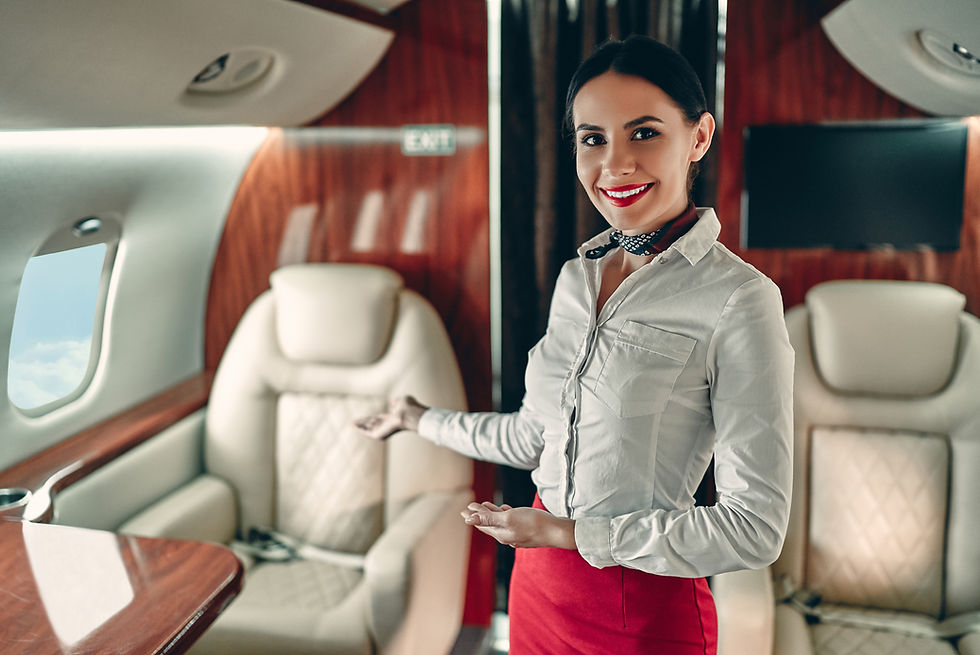What Do Corporate Flight Attendants Really Do?
- Dol Madaris
- Jun 9
- 2 min read
A Behind-the-Scenes Look at One of Aviation’s Most Demanding and Discreet Roles

The glamorous perception of private aviation often focuses on luxurious cabins, fine wines, and exclusive destinations. But behind every smooth, seamless journey is a corporate flight attendant (CFA) orchestrating the details with surgical precision and unwavering discretion.
So what do corporate flight attendants really do? A lot more than serve champagne at 40,000 feet.
Here’s a behind-the-scenes look at a typical day—and why this career demands far more than polish and poise.
Pre-Flight: Where Excellence Begins

Menu Planning with Precision
Every CFA begins with a carefully curated menu, personalized to the guest’s preferences. That means remembering the CEO’s favorite green juice blend, noting allergies, and ensuring that every element—down to the chocolate on the pillow—is intentionally selected.
Often, this requires:
Liaising with caterers across time zones
Vetting suppliers for quality and food safety
Cross-checking menus with flight durations, equipment limitations, and guest dietary needs
“A menu is never just a meal—it’s an extension of the guest experience.”
Cabin Setup: Creating a Flying Five-Star Hotel
Think of the aircraft as a boutique hotel. From crisp linens to scented hot towels, CFAs transform the cabin into a tranquil and elevated space. Setup may include:
Polishing glassware and silver
Steaming linens or uniforms
Aligning every pillow and magazine with obsessive attention to symmetry and cleanliness
No detail is too small when the goal is excellence.
In-Flight: The Art of Anticipation
Service That’s Subtle, Seamless, and Sincere
Unlike commercial airlines, where service is standardized, corporate aviation is bespoke. CFAs must anticipate needs before they’re spoken, offering personalized service with discretion and warmth. From timing meals around meetings to quietly adjusting the cabin temperature, everything is about intuitive care.
Guest Preferences? Memorized.
CFAs memorize profiles of frequent flyers—favorite drinks, seating preferences, even how they like their pillows fluffed. These tiny touches are what turn a flight into a memorable experience.
“The difference is in the details. Always.”
Safety First—Always
While elegance is essential, safety is the cornerstone. CFAs are highly trained in emergency protocols, medical response, and aircraft systems. Pre-flight briefings, cabin inspections, and readiness for any scenario are all part of the day.
They are not just there to serve—they’re the first responders in the sky.
Post-Flight: The Work Isn’t Over Yet

After landing, CFAs:
Tidy and reset the cabin
Complete post-flight reports
Restock supplies for the next mission
It’s not uncommon for the day to span 14+ hours, especially on international or back-to-back flights.
Final Thoughts: Why It’s a Career, Not a Job
Being a corporate flight attendant means wearing multiple hats: chef, housekeeper, concierge, nurse, sommelier, and safety officer—all while radiating calm and confidence. It requires grit, grace, and an unrelenting pursuit of excellence.
And while it may not always be as glamorous as it looks, for those who live for service and thrive in high-pressure, high-reward environments, it’s one of the most rewarding roles in aviation.
Jetiquette Training prepares future CFAs with the service etiquette, cultural intelligence, and polished professionalism demanded in this prestigious career.



Comments